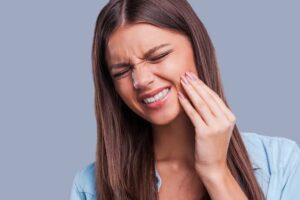Apollo Hospital Senior Associate Dental Surgeon
Ex ITBP Hospital Senior Dental Surgeon
Senior Dental Surgeon at Parthsarathy Painless Dental Clinic Shivpuri
Ex Dental Surgeon & Lecturer at Mansarovar Hospital & Research Center Bhopal
Senior Dental Surgeon & Healthcare Consultant at Practo
Dental Origin Pain

The nature of such pain may be spontaneous or may be induced in various ways. It can be intermittent or continuous but with lancinating exacerbations that radiate throughout the face and head. Dental pain is usually described as an aching sensation; sometimes throbbing, and when severe, may have a burning quality.
Pulpal pain :-
Pulpal pain may be classified as acute, chronic, and recurrent or mixed with periodontal element. Pulpal pain may resolve, become chronic or proceed to involve the periodontal structures by direct extension through the apex of the tooth root.
Acute pain :-
It is, most of the times, not completely localized by the patient.
Objective evidence such as deep caries, erosion, fracture or splitting may immediately identify the offending tooth.
The cause of acute pulpal pain is noxious stimulation of the pulpal receptors.
If the tooth structure is breached by splitting, a normal pulp may immediately become painful on contact with saliva or air. This occurs especially when masticatory stresses tend to open the split.
These conditions may be reversible unless congestion occurs causing pulpal gangrene.
The pain threshold of all deep receptors and nerve fibers that mediate pain is lowered by sustained hyperemia or inflammation. Thus, dental pulp that is hyperemic or inflamed is hypersensitive to all stimuli including electric stimulation, thermal shock, probing and percussion. And as the inflammatory process progresses spontaneous toothache may occur without any outside provocation.
Acute pulpal pain may range from occasional hypersensitivity caused by sweet and other minor stimulants to spontaneous violent throbbing toothache of intolerable intensity. It may be induced by any type of irritant or be wholly spontaneous.
It may be increased by both heat and cold or increased by heat and relieved by cold.
Pain may start without any apparent external irritation and frequently occurs at night when the patient lies down or when the patient leans down, most probably because of an increase in blood pressure.
The difference between a hyperemic pain caused by thermal reaction and acute pulpitis is that in acute pulpitis the pain does not necessarily resolve when the irritant is removed but continues to ache for few minutes and possibly for hours.
The usual relief for advanced acute pulpitis is cold water. Heat is the exciting factor in advanced acute pulpitis.
Chronic pain :-
Injured pulpal tissue may progress from an acute to chronic inflammatory phase.
It results from a continued low grade infection.
When chronic pulpitis occurs, pain response changes from extremely variable character of acute pulpal pain to milder and less variable vague discomfort that may not be described as pain at all. Tooth may become symptomless.
Toothache from dental cause :-
• Pain referred to teeth from inflamed nasal mucosa, nonspastic myofacial pain especially involving temporalis and masseter muscle, myofacial pain- dysfunction syndrome, pain of the heart muscles as a symptom of cardiac disease.
Neuritic pain such as those involving the maxillary teeth from inflammatory involvement of the superior dental plexus by the disease of the antrum and from neuritic conditions of the inferior alveolar nerve.
Neuralgic pain
Psychogenic pain
Periodontal pain :-
The receptors of the periodontal ligament are capable of rather precise localization of the stimulus, therefore periodontal pain of all types present no difficulty in diagnosis.
• The offending tooth is identified by applying the pressure to it laterally or axially.
It may occur as a primary periodontal inflammatory condition due to local causes such as trauma, occlusal stress, and contact with an adjacent embedded tooth, dental treatment like dental prophylaxis, occlusal interference, over contoured or under contoured, proximal contact area.
It may result from spread of pulpal infection or by direct extension from a nearby inflammatory condition involving an adjacent tooth, the maxillary antrum, or a spreading osseous infection.
When periodontal pain involves several teeth, especially opposing teeth, then occlusal overstressing either by clenching or bruxism should be considered. Overstressing of posterior teeth may occur as a result of decreased vertical height of the mandibular ramus due to osseous fracture or degenerative changes in the TMJ.